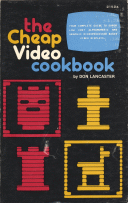
first edition, second print
In English
Publisher: Howard W. Sams & Co., Inc., 1979
ISBN: 0-672-21524-1 (Wikipedia Book Sources) (Wikipedian kirjalähteet)
LCCN: 78-51584 (Library of Congress)
The Cheap Video Cookbook picks up where the TV Typewriter Cookbook ended. Here is a brand new, super low-cost way to get words, pictures, and op-code out of a computer and onto on ordinary tv set with minimum modifications to either. You will find complete do-it-yourself nuts and bolts construction details with thoroughly documented and debugged support software.
Inside are details on the seven IC circuit called the TVT 6 5/6. You can build this as little as $20, and then software and module program it for virtually any alphanumeric format, including a scrolling 24 lines by 80 characters; or for virtually any graphics format including a high-resolution 256 × 256 mode and four-color graphics modes. And those seven ICs give cursor, loading, and editing capabilities limited only by your imagination, and do everything within the limited bandwidth ability of an ordinary tv set. The system runs on most any 6500 or 6800 system, and can be adapted to other microcomputers.
But, more important are the complete design details behind a totally new architecture which so dramatically simplifies display of computer memory that it is bound to eliminate many of the traditional approaches. The new twin concepts of the upstream tap and the SCAN microinstruction are expiored in depth so you can undestand and apply them to your own specialized microprocessor-based video display needs.
Round out the book are complete details on transparency techniques that let you compute and display the same time while keeping surprisingly high throughput.
| This page has been created by Sami Rautiainen. | |
| Read the small print. | Last content update: 2004-06-26 |